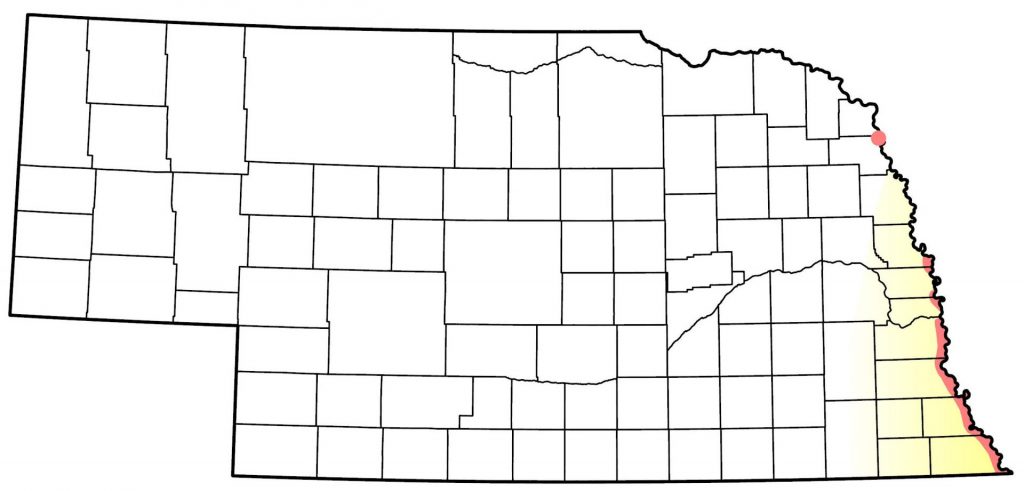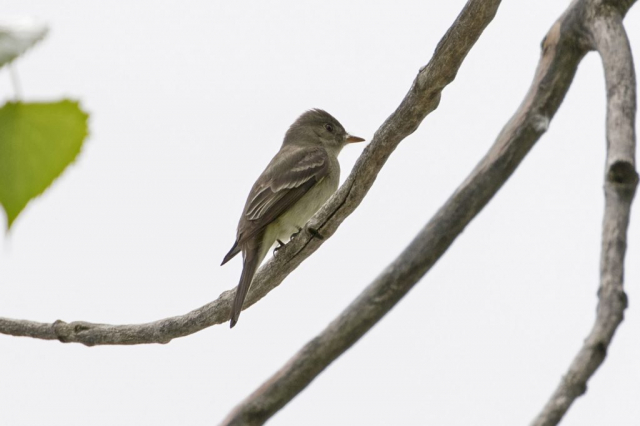Empidonax virescens
Status: Increasing. Locally uncommon regular spring migrant southeast, rare casual elsewhere. Locally uncommon regular breeder southeast, accidental northeast. Rare casual fall migrant east, accidental central.
Documentation: Specimen: UNSM ZM10562, 30 May 1910 Lancaster Co.
Taxonomy: No subspecies are recognized (AviList 2025).
Spring: May 5, 5, 5 <<<>>> summer
Earlier dates are 1-6 May 2022 Towl Park, Douglas Co, and 3 May 2014 Richardson Co.
Reports north and west of Washington and Lancaster Cos through early Jun, presumed overshoot migrants, are rare; one was at the former Ashford Scout Camp, now private, 17 May 2025, a singing bird was at Ponca SP, Dixon Co 24 May 2000, a specimen, UNSM ZM9389, was collected in Cherry Co 29 May 1932, four were netted, banded, and identified as this species by wing formula at Cedar Point Biological Station, Keith Co, 21-29 May 1996 (Brown et al 1996), and one was in Dakota Co 1 Jun 2021.
- High counts: 12 at Indian Cave SP 28 May 2012, 12 there 8 Jun 2019, 10 there 2 Jun 2019, and 10 there 10 May 2025.
Summer: This species has consolidated its range in the Missouri River Valley since the 1990s; regular summering occurs north to Washington and Douglas Cos. Two disjunct breeding locations, in Thurston and Lancaster Cos, are currently inactive (see below).
Acadian Flycatcher has become regular in summer only since around 1990 at Indian Cave SP and Fontenelle Forest. Prior to 1990 the only reports were in the Missouri River Valley, widely spaced, including a surprising nine egg dates 10 Jun-6 Jul for Douglas and Sarpy Cos from 1895-1901 (Hanson 1952, Mollhoff 2022), and six nests found during a survey in Sarpy Co in 1944 (Garrett 1944). At least some of the early records may have been referable to other species; Ducey (1988) suspected that “taxonomic confusion” might have been involved.
There were sporadic reports in the Douglas and Sarpy Cos area, most at Fontenelle Forest, 4 Jun 1992, 3 Jun 1994, 24 Jun 2002, two on 6 Jun 2004, and 1 Jul 2006, but in 2009 reports at Fontenelle Forest began to increase and became annual. In 2013 there were seven reports there of 14 birds 11-26 May, but peak count was three, suggesting duplication of sightings; at least four males were present in 2015.
The first record north of Sarpy Co was in Douglas Co, where at least one bird was present at Hummel Park 14-21 Jul through 3 Sep 1990 (Grzybowski 1990, 1991a). It nested at the same location in 1991, but a storm 22 Jun destroyed the nest (Grzybowski 1991b). Reports of 1-2 birds have continued at Hummel Park most years since, through 28 May 2024. In Washington Co, at Neale Woods, first records were 30 May-4 Jul 1997 and 30 May-19 Jun 1998 and have continued there in both Washington and Douglas Cos since.
An isolated northern series of records of summering and nesting was in Thurston Co 1998-2001 at Ashford Scout Camp; A singing male was present 13-14 Jun 1998, a pair was there 3 Jul 1999 (Jorgensen 2001), a pair was found 4 Jul 2000, and one was there 16 Jun 2001.
There has been little information published on early sightings at Indian Cave SP; the first known record there was 15 Jun 1994. There were up to three birds on Trail 9 through 25 Jun 1995, and since then it has been a fairly common component of the avifauna there, although nesting has not been confirmed. The best count to date is 12 on 28 May 2012, although recent standardized surveys at this location suggest the number of birds at this site during June may number in the hundreds (Jorgensen et al 2014). In Cass Co, there are continuing records of 1-2 birds at Schramm SP, beginning 18 Jun 1991; additional reports there are of 1-2 on 14-21 Jun 2008, and singles there 20-28 Jun 2013 and 7 Jun 2021.
Reports of singing males began at Wilderness Park, Lancaster Co 23 May 2009 and 31 May-10 Jun in 2010. Since 2010, at least one Acadian Flycatcher has been present during summer, although oddly there are no records since 2020. An older Lancaster Co report was 22 Jul 1988, and more recently one was at Spring Creek Prairie, Lancaster Co 18 May 2016.
The only additional breeding season sightings away from the known breeding locations discussed above are of one in western Douglas Co 20 Jun 2013, and one singing northwest of Verdigre in Knox Co 10-22 Jul 2009, first for the county (Mark Brogie, personal communication).
Fall: summer <<<>>> Aug 10, 11, 12
Later dates are 16 Aug 2015 Richardson Co, 16 Aug 2024 Sarpy Co, 29 Aug 2019 Sarpy Co, 31 Aug 2019 Nemaha Co, 3 Sep 2003 two photographed and measured Thomas Co, 4 Sep 2020 Nemaha Co, 8 Sep 2015 Lancaster Co, and 11 Sep 2013 Douglas Co.
Departure occurs by mid-Aug. Substantiated records in Kansas extend to 30 Sep (Thompson et al 2011) and to 20 Sep in Missouri (Robbins 2018).
Comments: An adult male specimen assumed to have been collected by Cary in Sioux Co 26 May 1900 (Cary 1901, Crawford 1901, Rosche 1982) cannot now be located; Swenk and Dawson (1921), who had not seen the specimen, suggested that Cary’s report may have been based on a misidentification, as a specimen taken in the same place two days later by Hunter and said to be identical in appearance to that of Cary was identified as “E. traillii brewsteri” (apparently a Willow Flycatcher) by Oberholser.
Images
Abbreviations
SP: State Park
UNSM: University of Nebraska State Museum
Literature Cited
AviList Core Team, 2025. AviList: The Global Avian Checklist, v2025. https://doi.org/10.2173/avilist.v2025.
Brown, C.R., M.B. Brown, P.A. Johnsgard, J. Kren, and W.C. Scharf. 1996. Birds of the Cedar Point Biological Station area, Keith and Garden Counties, Nebraska: Seasonal occurrence and breeding data. Transactions of the Nebraska Academy of Sciences 23: 91-108.
Cary, M. 1901. Birds of the Black Hills. Auk 18: 231-238.
Crawford, J.C., Jr. 1901. Results of a collecting trip to Sioux County. Proceedings of the Nebraska Ornithologists’ Union 2: 76-79.
Ducey, J.E. 1988. Nebraska birds, breeding status and distribution. Simmons-Boardman Books, Omaha, Nebraska, USA.
Garrett, F.D. 1944. A survey of nesting birds in the Fontenelle Forest. NBR 12: 25-31.
Grzybowski, J.A. 1990. Southern Great Plains Region. American Birds 44: 1152-1154.
Grzybowski, J.A. 1991a. Southern Great Plains Region. American Birds 45: 122-124.
Grzybowski, J.A. 1991b. Southern Great Plains Region. American Birds 45: 1132-1134.
Hanson, M.L. 1952. Some oological records of Nebraska. NBR 20: 31-35.
Jorgensen, J.G. 2001. 1999 (Eleventh) Report of the NOU Records Committee. NBR 69: 85-91.
Jorgensen, J.G. 2014. Breeding Bird Diversity, Abundance and Density at Indian Cave and Ponca State Parks, Nebraska, 2012-2014. Nongame Bird Program of the Nebraska Game and Parks Commission, Lincoln, Nebraska, USA.
Kent, T.H., and J.J. Dinsmore. 1996. Birds in Iowa. Publshed by the authors, Iowa City and Ames, Iowa, USA.
Mollhoff, W.J. 2022. Nest records of Nebraska birds. Nebraska Ornithologists’ Union Occasional Paper Number 9.
Pyle, P. 1997. Identification Guide to North American Birds. Part I, Columbidae to Ploceidae. Slate Creek Press, Bolinas, California, USA.
Robbins, M.B. 2018. The Status and Distribution of Birds in Missouri. University of Kansas Biodiversity Institute, Lawrence, Kansas, USA.
Rosche, R.C. 1982. Birds of northwestern Nebraska and southwestern South Dakota, an annotated checklist. Cottonwood Press, Crawford, Nebraska, USA.
Swenk, M.H., and R.W. Dawson. 1921. Notes on the distribution and migration of Nebraska birds I. Tyrant Flycatchers (Tyrannidae). Wilson Bulletin 33: 132-141.
Thompson, M.C., C.A. Ely, B. Gress, C. Otte, S.T. Patti, D. Seibel, and E.A. Young. 2011. Birds of Kansas. University Press of Kansas, Lawrence, Kansas, USA.
Recommended Citation
Silcock, W.R., and J.G. Jorgensen. 2025. Acadian Flycatcher (Empidonax virescens). In Birds of Nebraska — Online. www.BirdsofNebraska.org
Birds of Nebraska – Online
Updated 25 Aug 2025, Map updated 27 Jun 2025

